M&A, Antitrust, and the Board Room in 2019: Challenges and Conundrums for the West Coast
February 20, 2019
Recap
- Recap
- Agenda
- Participants
Recap
The fifth annual M&A, Antitrust, and the Board Room: Challenges and Conundrums for the West Coast Conference opened with observations from conference Co-Chair and Cleary Gottlieb corporate partner Ethan Klingsberg about how each year this event alternates between focusing on areas where an urgent “heads up” or alert is needed to demystify and navigate intimidating areas of uncertainty vs. focusing on exploration of aspirational directions for corporations, regulators, courts, and investors.
The 2018 conference focused on the latter with our discussions of the possibilities for the use of the Delaware benefit corporation statute for those startups considering future IPOs, the imminent availability of objective sustainability metrics and guidelines for meaningful ESG disclosure, the implications of opportunities for longer-term and larger VC investments, creative perspectives starting to be used in public company boardrooms when construing what is “in the best interests of the corporation and its stockholders,” how to integrate the insights of the best-seller Throwing Rocks at the Google Bus into workable corporate and legal proposals, how to make antitrust enforcement a vehicle in Europe and the U.S. for the promotion of innovation, the potential that the progeny of Corwin and MFW presents for efficiency and rationality in transactional and fiduciary duty litigation, and how corporations could leverage and promote the potential for convergence among institutional investors focused on not only increasing returns but also long-termism.
In 2019, however, Ethan observed that the themes would be swinging back in the direction of trying to make sense of uncertainty and alert ourselves to pitfalls. While last year, we discussed dual class structures as a foundation for stability to promote moonshot-ism, this year there would be a discussion of an audacious effort to undermine a dual class structure that has left dual class companies, controlling stockholders, and independent directors wondering about how stable the frameworks for their capital structures actually are. While last year we would discuss with regulators how to grow regulation in creative new directions to promote innovation, this year we would be reacting to a pervasive anxiety about national security regulatory regimes, and therefore we would be calling on insiders from Washington, D.C. to explain to us exactly what the new and future CFIUS and export control regimes mean for transactions, private equity, VC investing and emerging technologies.
Similarly, we would be looking to antitrust insiders to help us understand what the U.S. and European antitrust regimes have in store for startup M&A and for what we need to be on the watch so that we can assure we do not run into regulatory troubles in connection with startup M&A. While last year, Corwin and MFW were guiding lights, this year we would be hearing a lot more about the limits of each of these doctrines and how the freedom provided by LLC and LP statutes have turned out actually to have created minefields characterized by the implied covenant of good faith as a means to address cavalier or aggressive conduct.
In addition, this year Alex Stamos would be telling us how flawed our board, regulatory, and governance processes are when it comes to cybersecurity and data privacy, how major a problem these flaws actually are for us, and what steps ought to be taken urgently in response to this fiasco. Finally, on the investor front, we would be hearing about how the nature of investor relations needs to start changing in a number of significant ways due to new needs of independent directors and investors.
Below are images and key takeaways from the day’s discussions.
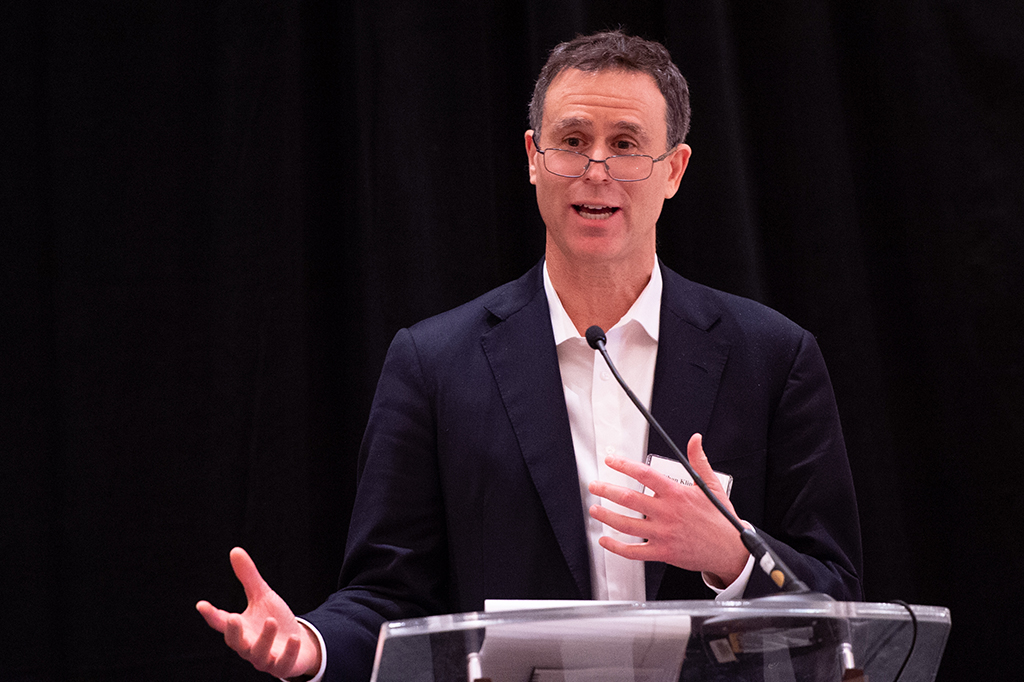
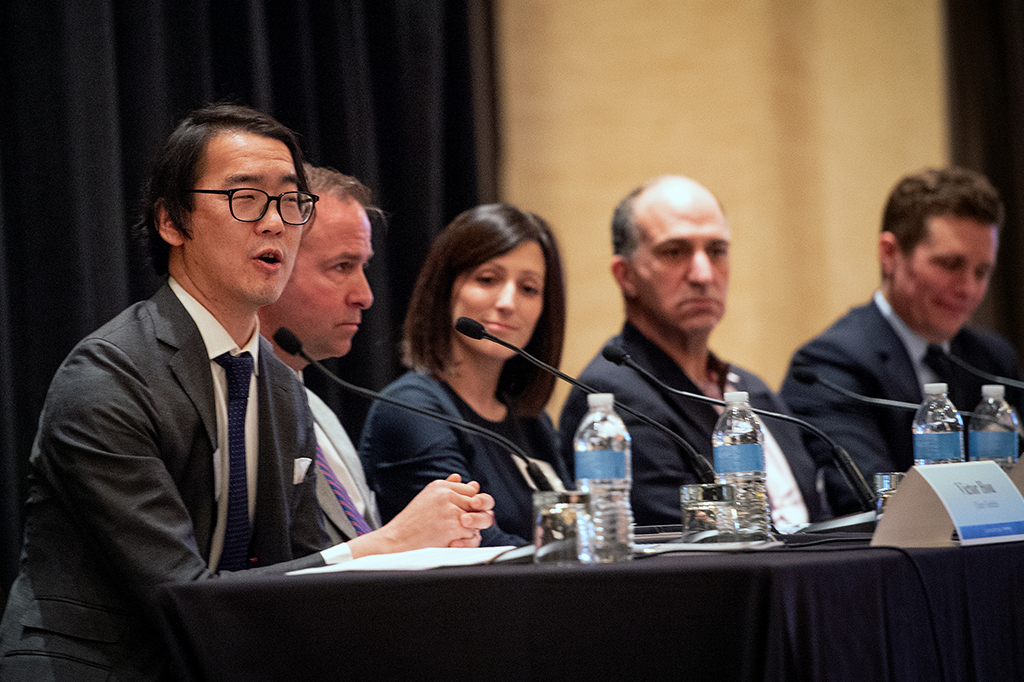
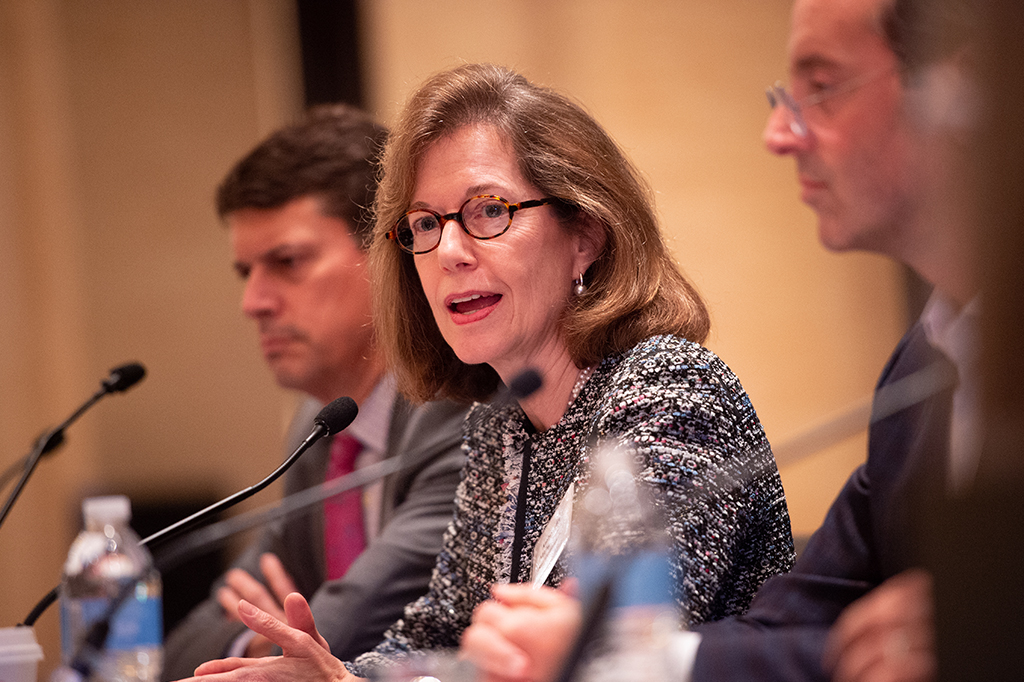
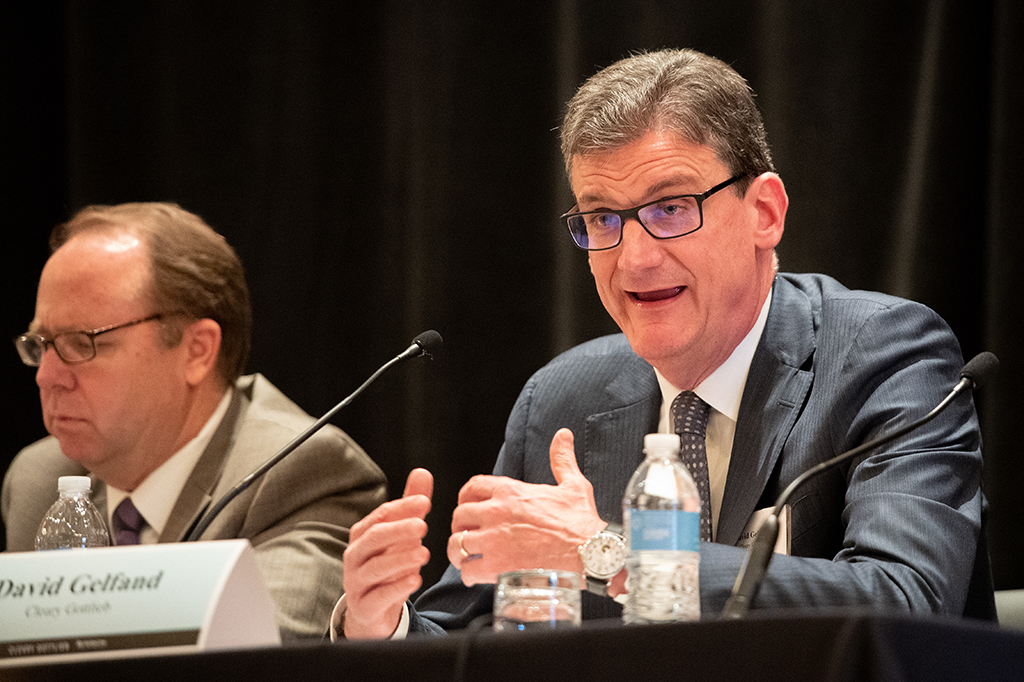
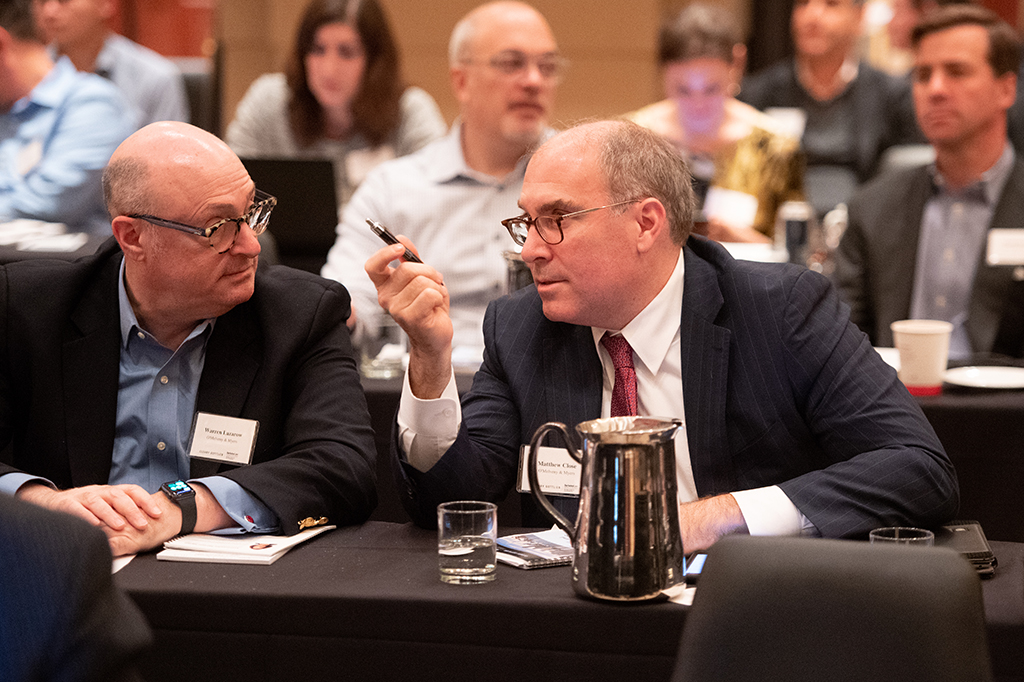
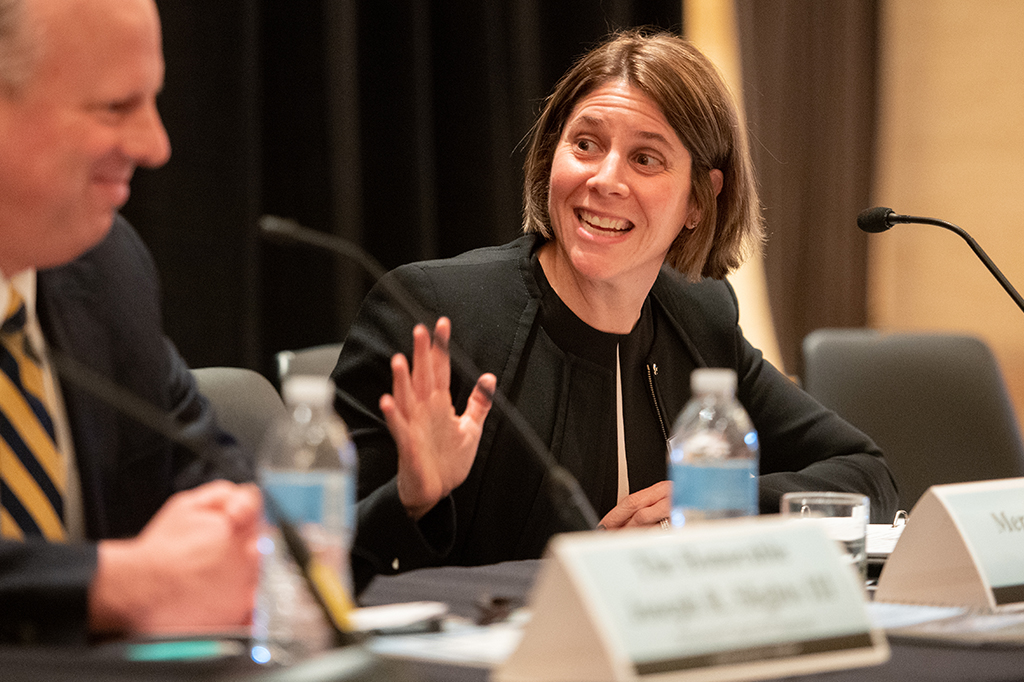
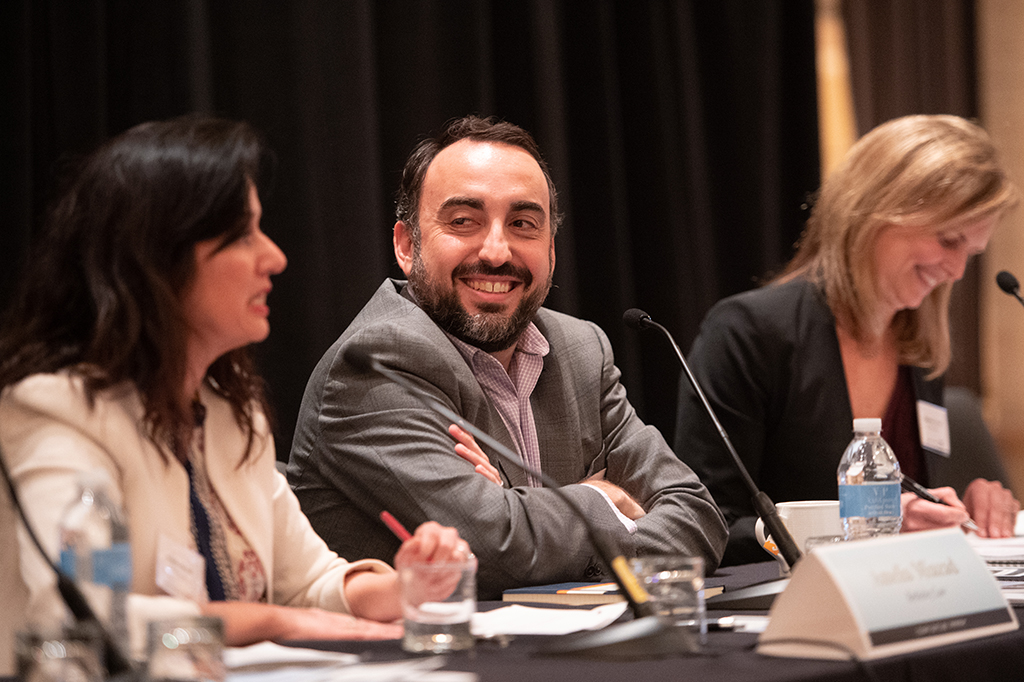
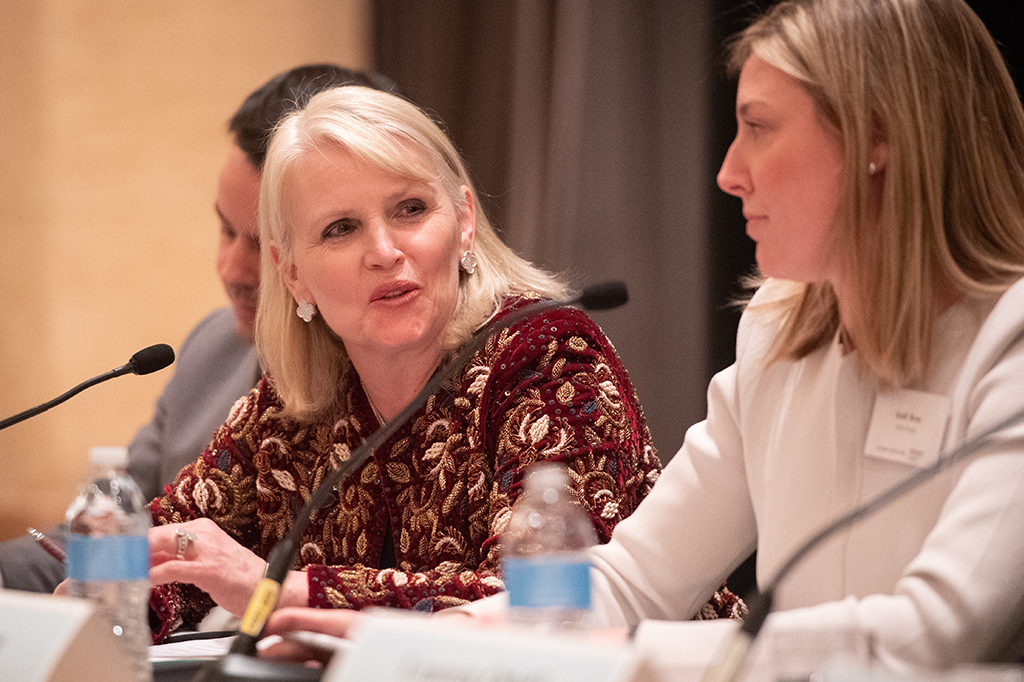
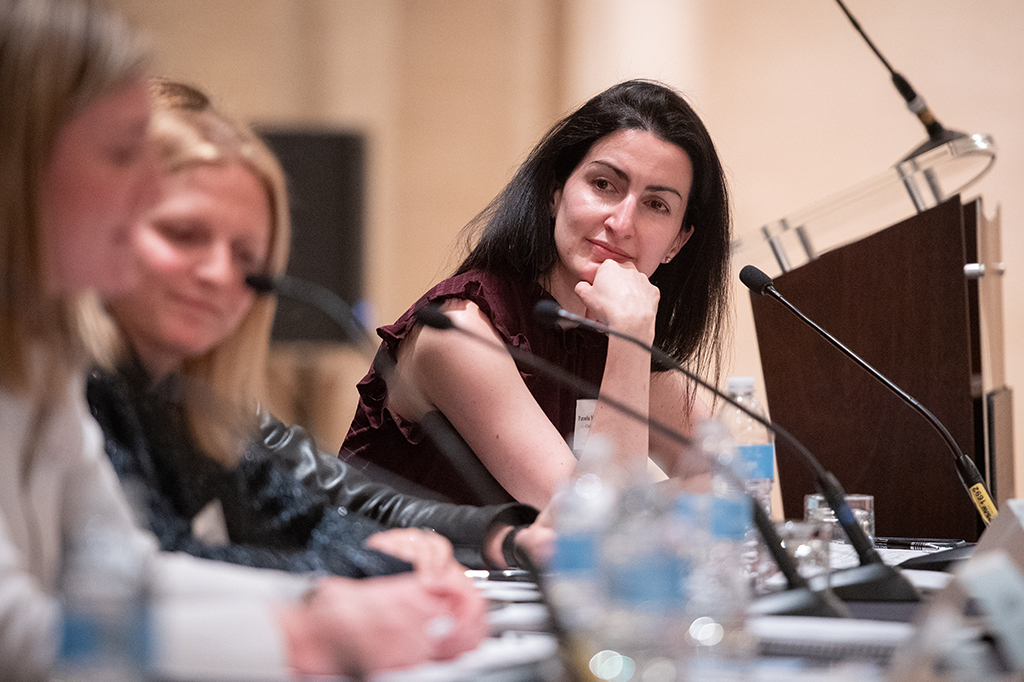
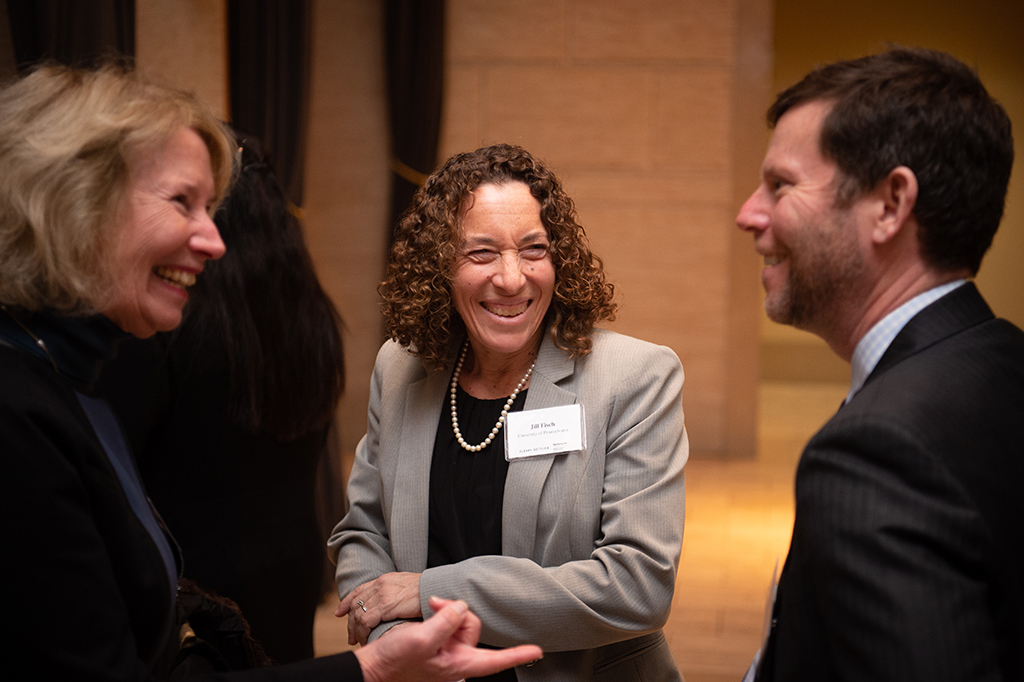

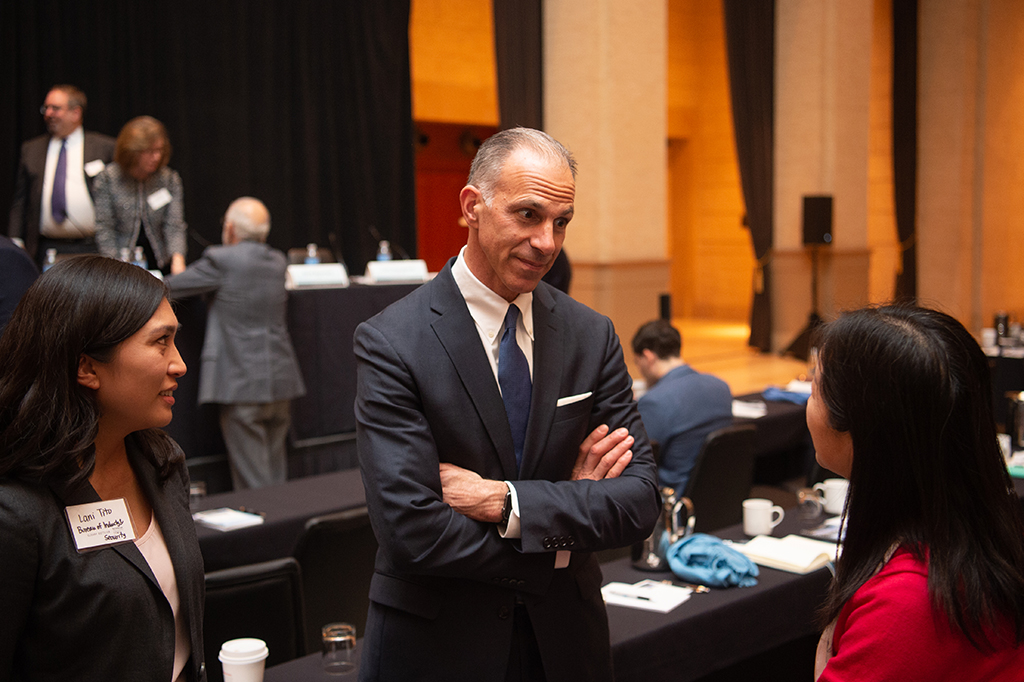












Implications of the CBS/Redstone Case for Dual-Class Companies
This first session consisted of a lively discussion among some of the senior advisors involved in the Redstone family’s recent legal battle with CBS, including Jonathan Knee, a Senior Advisor at Evercore; Sara Evans, a partner at Finsbury; Matt Fischer, a partner at Potter Anderson & Corroon LLP; Victor Hou, a litigation partner at Cleary who was one of the lead litigators in the CBS litigation; and moderator Paul Tiger, a Cleary M&A partner who represents the Redstone family entity, National Amusements Inc., on corporate matters.
The panel members talked about their experiences from that headline-grabbing case and its implications for dual-class companies, and their boards and counsel, going forward.
After Paul and Victor reviewed the unusual facts of the case (previously summarized on our blog), Paul noted that one of the arguments put forward by CBS suggested that a dual-class structure was inappropriate or improper in and of itself and asked Jonathan – if that was the case, wouldn’t we see evidence of this in trading prices? Jonathan started by observing that there is no empirical evidence that dual-class structures have a negative effect on a company’s value – some dual-class companies trade with their peers, while others do not, but those dislocations can be attributed to the underlying business. In response to Paul’s question about whether this is an area where the exchanges or other regulators need to intervene (to require sunsetting or impose a one-share one-vote principle) when it wasn’t a secret that the Redstones controlled CBS, Jonathan said that in most cases it should be for markets to decide on the merits of a dual-class structure for any given company, as long as everyone knows what to expect, and in those cases where investors believe the dual-class structure is impairing the value of the company, they have other options, such as selling their shares or pushing for a reclassification transaction where the high-voting share class is compensated for its loss in relative voting rights, rather than simply wresting control from the holders of high-vote stock without compensation. For more on reclassification transactions to unwind dual class structures, see this blog post.
In response to a question from the audience, the panel then discussed whether it would be incumbent on a board to dilute the controlling stockholder if it knew that doing so would raise the value of the entire company or benefit the public holders. Matt explained that, under Delaware law, the board owes fiduciary duties to all stockholders, including the controlling stockholder, and that the board would have to show compelling justification for such an effort. Moreover, as Jonathan pointed out, it’s universally agreed that voting control has value and referred back to the large body of dual-class recapitalizations. But, as Matt explained, CBS argued that it had a compelling justification for the dilutive dividend given its allegations of a threatened breach of fiduciary duty by NAI, a position that the Redstones and NAI disagreed with. Matt went on to note that, in addition to NAI’s position that no threat existed, NAI believed the dilution sought by the CBS board to be disproportionate to the perceived threat.
The discussion then turned to an interesting privilege issue. As Matt explained, certain members of the CBS board and management perceived a conflict between NAI, as the controlling stockholder, and the company, and they sought legal advice from the CBS board’s counsel regarding that perceived conflict for years before the dilutive dividend was proposed. The issue was whether the NAI-affiliated CBS directors were entitled to those otherwise privileged communications in discovery. Matt explained that the default rule is that directors of a Delaware corporation have unfettered access to communications with board counsel, but there is a limited exception when “manifest adversity” is present (and when that is clearly communicated to the affiliated directors). Paul noted that this presents a challenge for board counsel faced with potential conflicts among the board as advice may be sought from board counsel regarding the controller at an early stage before the adversity is manifest and that may require surfacing the issue with the controller prematurely. Victor agreed and discussed some of the ways that counsel might try to address this issue.
In response to a question from Paul, Sara then ended the session by discussing the complications of managing such a high-profile transaction from a public relations perspective, including commenting on ways advisors can be best prepared to deal with leaks and reduce what was at times rampant press speculation, in order to better control the narrative.
Implications of CFIUS and New Export Controls for the Future of Dealmaking
The Honorable Richard Ashooh, U.S. Assistant Secretary of Commerce for Export Administration, opened the discussion with a keynote address on the significant policy initiatives that the Bureau of Industry and Security (BIS) has recently undertaken to address technology security while advancing U.S. technological leadership.
The Assistant Secretary observed that, while 20 years ago, the majority of advanced technology spending in the U.S. that was relevant to national security was being driven by the national security establishment itself, there has been a global shift from government to private industrial spending on technology such that today, government spending constitutes a much smaller fraction of spending on technology. In the realm of export controls, this means that regulators can only succeed in identifying emerging technologies as a national security concern by working together with the innovators of such technology and engaging earlier in the technology life cycle.
He asserted that the advance notice of proposed rulemaking (ANPRM) published by the Bureau on November 19, 2018, seeking public comment on criteria for identifying emerging and foundational technologies that are essential to U.S. national security, represents a significant step in this direction. The Assistant Secretary explained that the purpose of this ANPRM is to identify those technologies not yet listed on the Commerce Control List administered by BIS or controlled multilaterally, because they are emerging technologies and have not yet been evaluated for their national security impact; he emphasized that BIS needs the public’s help in these efforts.
The Assistant Secretary said that the imperative for this action comes from the Export Control Reform Act of 2018 (ECRA), which authorized the U.S. Department of Commerce to establish appropriate controls on the export, reexport, or transfer of emerging and foundational technologies. Thanks to ECRA, according to the Assistant Secretary, the export control system is now legislatively and substantively validated to reflect today’s challenges.
He then shifted to discuss how efforts to effectively regulate foreign direct investment require the continued modernization of the Committee on Foreign Investment in the United States (CFIUS). The enactment of the Foreign Investment Risk Review Modernization Act (FIRRMA) in August 2018, and the initiation of the FIRRMA pilot program that requires mandatory notification of foreign investment in U.S. businesses engaged in certain “critical technologies,” was intended to address the regulatory challenges presented by foreign direct investment. He alerted us that next steps are likely to involve specific rules governing specific technologies rather than another conceptual release.
The Assistant Secretary described how what he views as thoughtful and successful legislative processes is resulting in regulatory efforts in the areas of export controls and foreign direct investment are now in a position to be knitted together in a complementary fashion. The Assistant Secretary emphasized that these complex and numerous changes would not be effective without the proactivity of the regulated community.
Building on the background of the Assistant Secretary’s opening address, a panel moderated by Cleary partner Paul Marquardt, who from Washington, D.C. leads the firm’s national security regulatory practice focusing primarily on transactional matters, took to the stage to discuss where we stand on CFIUS and export controls and what lies ahead. The panelists were Brad Berenson, General Counsel of TPG; The Honorable Clay Lowery, Managing Director of Rock Creek Global Advisors; and Ambassador Miriam Sapiro, Managing Director of Sard Verbinnen & Co. and Vice Chairman of SVC Public Affairs.
The panelists shared their reactions to the Assistant Secretary’s speech. Clay explored the historical link between the export control regime and CFIUS and how the present day dual mandate to fix the export control regime and CFIUS is furthering the overlap. Miriam highlighted the critical importance of multilateral cooperation to the success of the regulatory regime and noted that European countries are taking similar steps to strengthen their respective regimes and better coordinate with the United States. Brad endorsed the Assistant Secretary’s comments regarding the constructiveness of the FIRRMA legislative process—the private equity industry, which has a key interest in merger controls and approvals, was heavily engaged from the early stage right through to the end of the legislative process.
Paul asked the panelists if, looking ahead, they could suggest one tweak to the final regulations, what that would be. Brad suggested clarifications to the definition of “foreign person,” so that funds can know with certainty when an acquisition vehicle falls into such category. Miriam expressed hope that CFIUS would continue to demystify the regulatory process and thereby build public confidence in the process. Clay suggested narrowing the scope of CFIUS review, perhaps streamlining certain elements of the process for countries that are important allies of the U.S.
Responding to a question from Paul regarding claims that CFIUS is protectionist, the panelists further explored whether, during the current administration, trade disputes have had any influence on the CFIUS process. Miriam disagreed with the characterization of CFIUS as a protectionist regime; she emphasized that, against the current backdrop of increased scrutiny of China and the unpredictability of the views of the current administration, it’s important to remember that at the heart of CFIUS lies two questions: Is there a national security threat, and if so, can it be mitigated? Those questions remain the focus of CFIUS regardless of the administration in charge. Brad highlighted the difference between the reality of the CFIUS review process and the perception among the investor community; he noted that, perhaps in part due to the current active deal market, whether a CFIUS filing is required is being treated almost as a threshold question, and bidders whose bids may entail a filing are essentially disfavored.
Following Brad’s comments, Miriam suggested a few things that companies can do to maximize their chances of emerging successfully from CFIUS review, including understanding the politics at play and building trust with the CFIUS committee. Paul then shared a number of useful insights on how to succeed before CFIUS and how the CFIUS process will be evolving in the coming years.
The session concluded with a discussion of the timing challenges posed by the CFIUS review process. The panelists noted that, although Congress and federal agencies have taken legislative steps to clarify and shorten the often drawn-out timeline, it will take some time for more staff to be hired and additional resources to be invested in a way that will make a meaningful difference.
How Antitrust Regulators Should Assess Acquisitions of Innovative New or Potential Competitors
This session featured contributions from Kathleen Bradish, counsel at Cleary and former Assistant Chief of the U.S. Department of Justice Antitrust Division’s International Section; Michael Moiseyev, Assistant Director of the Federal Trade Commission’s Bureau of Competition; and Steve Tadelis, Professor of Economics, Business and Public Policy at the UC Berkeley Haas School of Business.
Facilitated by Cleary partner David Gelfand, the former Deputy Assistant Attorney General for Litigation at the Antitrust Division of the U.S. Department of Justice, this session had regulators, academics, and private practitioners candidly sharing their views on the antitrust implications of innovative new or potential competitors.
The discussion kicked off with a recognition that the vast majority of antitrust case law deals with existing horizontal competition. The issue of how to view companies that are recent competitors, or that are poised to become competitors in the future, is an emerging topic and implicates questions such as: What is the probability that the firm will emerge as a competitor? What is the pro-competitive effect that its entry into the market is likely to have? Does the firm enjoy an entry advantage over other firms in the market? Michael noted that the historical case law is unforgiving in terms of the standard imposed on the government to show anti-competitive effects; the government bears the burden of proving a high probability that a company is actually going to become a competitor.
Professor Tadelis delved into the economics of technology platform acquisitions. He noted that with the relative ease of early stage entry into the market and record levels of VC investment into technology disrupters, we need to carefully consider whether acquisitions really are creating barriers to entry as opposed to facilitating competition. Professor Tadelis argued that technology startups, even when they have an disruptive technology, often fail due to poor execution and poor marketing and that acquisitions of startups by mature companies can make these startup businesses more competitive and more innovative by addressing these weaknesses. The audience challenged Professor Tadelis, arguing that technology acquirers are actually seeking personnel who are superior at execution and first-mover brands that have superior marketing value, and therefore the acquisitions may be anti-competitive even if of a startup.
The discussion then pivoted to the approach taken to this issue by the international enforcement community. Kathy noted that the debate is cast differently abroad and, in contrast to the U.S., already assumes anti-competitive effects. The proposed regulatory responses are far more drastic, and several European jurisdictions already have changed their antitrust laws to capture more of these acquisitions of startups in their regulatory reviews. She emphasized the need to pay attention to new (lower) thresholds for antitrust filings and proposals to shift the burden of proof from regulators to the merger parties.
Perspectives From the Delaware Court of Chancery With Vice Chancellor Joseph R. Slights III
The conference shifted to a “fireside chat” between Vice Chancellor Joseph R. Slights III of the Delaware Court of Chancery and Meredith Kotler, a Cleary litigation partner who has successfully argued a number of high-profile cases in the Delaware Court of Chancery.
Much of the discussion was about issues that come up in a case in which the defendant directors are seeking to rely upon Corwin so that they make take advantage of the presumption of the business judgement rule. Meredith discussed with the Judge when the court will find a stockholder to be a controller (such that Corwin cleansing does not apply). In this regard, Meredith noted that the Vice Chancellor had recently found at the pleading stage that it was reasonably conceivable that Elon Musk was a controller of Tesla, even though he owned only approximately 22 percent of the shares. Emphasizing that he did not “find” Musk to be a controller, only that it was “reasonably conceivable” that he was for purposes of deciding whether to dismiss the case at the pleading stage, the Vice Chancellor explained that the question of whether a stockholder with less than 50 percent voting control is a controller (because the stockholder dominated the independent directors’ and stockholders’ free will) is a fact-intensive inquiry, and the alleged facts in Tesla were unusual.
Meredith next discussed with the Judge whether the Delaware courts had decided which stockholders count as “disinterested” for purposes of Corwin cleansing (which applies only when a majority of the disinterested stockholders approve the merger). The Vice Chancellor noted that this issue had been raised but not yet been decided, including in the Tesla case. In response to a point raised by Meredith about whether it should make a difference whether the stockholders are active or passive, the Vice Chancellor said he could see arguments on both sides and expected this issue to come up again soon.
Meredith and Vice Chancellor Slights discussed two recent Corwin cases in which he had found the stockholder vote was not fully informed. Vice Chancellor Slights explained that these cases followed two decisions from the Delaware Supreme Court over the summer, Appel v. Berkman, 180 A.3d 1055 (Del. 2018), and Morrison v. Berry, 191 A.3d 268 (Del. 2018), which together sent a message that the court should be careful when applying Corwin and that stockholders cannot be deemed to have ratified what they did not know. He also noted that these decisions reiterated that the question is not whether the omitted information would have changed stockholders’ minds, but whether it would have been important to the stockholders. Meredith and Vice Chancellor Slights agreed that this is a difficult line to draw.
Returning to a topic from earlier in the day, Meredith discussed with the Judge how dual-class stock structures would be received in the Delaware Court of Chancery, particularly given that they are permissible under the Delaware General Corporation Law (DGCL). Vice Chancellor Slights said he thought it would ultimately be a question of equity, depending on the facts of each case. Although he did not see the Delaware courts making any sweeping declarations about dual-class stock, he said he thought the court would step in to police abuses of such structures if necessary, drawing an analogy to MLP cases in which the court has increasingly applied the implied covenant of good faith and fair dealing to address egregious cases.
The Role (and Limits) of Law in Data Privacy and Security
The next session was a dialogue with Alex Stamos, former Chief Security Officer of Facebook, about the roles of law and in-house and outside lawyers in data privacy and security, moderated by Cleary partner Katherine Mooney Carroll, a former Counselor to the Secretary of Defense on cybersecurity among other matters and one of the leaders of Cleary’s work on cybersecurity and data privacy, and Amelia Miazad, Founding Director and Business Law Lecturer at the Business in Society Institute of UC Berkeley School of Law.
The discussion began by exploring shifting norms and uncertainty with respect to privacy. Katherine then noted that in a data breach scenario, one of the most challenging issues is when to disclose a problem. Alex said that one of the issues is that tech companies are unflaggingly optimistic, but the reality is that when, for example, 2.2 billion people use your platform, some of those people will use the platform for sinister purposes. Tech companies do not want to talk about that, he added, but they should.
Alex explained that Facebook’s investigation of Russian ads from the 2016 U.S. presidential campaign was not required by any law and was disclosed voluntarily. Moreover, since it was not a breach, the norms of disclosure were unclear. Alex said that various laws constrained Facebook from releasing the content of the ads, despite mounting public pressure to do so. He said this was an example of a time when it would have made sense for Facebook to take the legal risk of violating privacy laws, noting he was skeptical that the FTC or others would have challenged Facebook for releasing information about the Russian ads.
Katherine discussed how legal and other considerations should be balanced in these kinds of scenarios. Alex thought it was a problem that legal departments often oversee crisis management. In his opinion, legal risk is not always the biggest risk facing a company. On the other hand, Alex acknowledged that laws are important, which is why he thinks there should be a single federal privacy statute (rather than a patchwork of state laws) with a single competent regulator to implement it. He noted that the FBI is good at finding and indicting people after the fact but not suited to preventing cyberattacks before they take place.
Alex noted that the public only hears about a small percentage of data breaches that are discovered, and security professionals only catch a small percentage of the breaches that occur. Companies have to accept the reality that they will be breached; the key is to incentivize them to disclose when they have been. He noted that the class actions that are inevitably filed after a data breach do nothing to provide the right incentives. He contrasted this with the NASA/FAA system of aviation safety reporting, which encourages airlines to report safety incidents rather than punishing them for doing so.
Finally, Amelia asked about governance structures around cybersecurity and privacy and reporting lines for chief information security officers (CISOs). Alex noted that many CISOs do not have the necessary power to protect their companies, and the optimal way to ensure cybersecurity is to push the risk of a cyberattack to the relevant business lines. Alex said that, as of now, boards tend not to not play a significant role in cybersecurity, in part because they meet infrequently and are unqualified (“How many directors have ever even changed a hard drive?”). He noted that most CISOs find their reporting structures to present challenges. He suggested that it seems to make more sense for cybersecurity oversight to be handled by a Risk Committee rather than an Audit Committee at the board level, as the latter may be more focused on financial expertise. With respect to management reporting lines, and he noted that CISOs and chief information officers often have very different mandates so that having the CISO report to the CIO is not typically going to be an effective reporting line, and he noted that many large banks put cybersecurity under risk, which seems more effective. He added that more work needs to be done so that each board has at least one technologically conversant member who can oversee competently cyber-risk.
How Stockholders and Independent Directors Are Changing the Role of Investor Relations
The panelists for the event’s final session included Chris Hill, Chief Legal Officer and Head of Global Corporate Citizenship at Dun & Bradstreet; Lauren Odell, Partner and Chief Operating Officer at Gladstone Place Partners; Andrea Rose, Partner at Joele Frank; Laura Stein, Executive Vice President and General Counsel of The Clorox Company; and Pat Tucker, Managing Director of The Abernathy MacGregor Group, Inc.
In a discussion moderated by Cleary partner Pamela Marcogliese, who represents a number of Bay Area companies in connection with their shareholder engagement, disclosure, securities law, and governance matters, the panelists delved into how investor relations (IR) has changed recently. The panelists observed that the expectation of the investment community and independent board members with respect to the role of IR has changed dramatically; IR has evolved from a person who communicates with Wall Street and does some marketing to a critical function staffed by professionals who have a deep understanding of the company’s business and metrics and partner with Legal and Finance to best position the company with a spectrum of investors.
The panelists discussed ways for the board to receive information from and to be prepared by IR. The panel made recommendations for making updates by IR—addressing various topics such as reactions to earnings calls, financial performance relative to peers, and readiness level for activism—a standing agenda item for either the full board or a committee. In addition, the group discussed how IR can play an important role and provide useful guidance to the board through board offsites and in preparing board members for participation in investor presentations.
The panel discussed useful strategies for assuring that the board hears important information from the IR front, understands how the investor base has acted historically, understands the investor base as a diverse set of constituents (rather than a monolithic block), and is empowered to act in response.
The session discussed how to design useful and practical tabletop exercises for management and/or the board that challenge senior individuals to go through the process of handling a crisis.
The discussion concluded by sharing strategies for efficiently and effectively communicating with investors on ESG matters, an area that is taking up increasing amounts of time, is prone to missteps by corporations, and has increasing importance for maintaining investor support of management and the board.Agenda

San Francisco, California
Tuesday, February 5, 2019 |1:00 p.m.
Bently Reserve | 301 Battery Street, San Francisco, CA 94111
Cocktail reception to follow
What does Redstone/CBS mean for the future of controlled companies, dual-class, and independent directors?
Discussion Leaders:
- Sara Evans, Partner, Finsbury
- Matt Fischer, Partner, Potter Anderson & Corroon LLP
- Victor Hou, Partner, Cleary Gottlieb
- Jonathan Knee, Senior Advisor, Evercore
Moderator:
What do CFIUS and new export controls mean for the future of dealmaking, venture and private equity capital, merger agreements, strategic alliances, and R&D?
Keynote Address:
- Rich Ashooh, U.S. Assistant Secretary of Commerce for Export Administration
Discussion Leaders:
- Brad Berenson, General Counsel, TPG
- The Honorable Clay Lowery, Managing Director, Rock Creek Global Advisors
- Ambassador Miriam Sapiro, Managing Director, Sard Verbinnen & Co. and Vice Chairman, SVC Public Affairs
Moderator:
- Paul Marquardt, Partner, Cleary Gottlieb
How should antitrust regulators assess acquisitions of innovative new or potential competitors?
Discussion Leaders:
- Kathleen Bradish, Counsel, Cleary Gottlieb; former Assistant Chief of DOJ Antitrust Division’s Int’l Section
- Michael Moiseyev, Assistant Director, Bureau of Competition, Federal Trade Commission
- Steve Tadelis, James J. and Marianne B. Lowrey Chair in Business and a Professor of Economics, Business and Public Policy at Haas School of Business, University of California, Berkeley
Moderator:
- David Gelfand, Partner, Cleary Gottlieb; former Deputy Assistant Attorney General for Litigation in the Antitrust Division of the U.S. Department of Justice
What do the latest directions at the Delaware Court of Chancery mean for the corporate law advice you will be giving and receiving?
Discussion Leader:
- The Honorable Joseph R. Slights, Vice Chancellor, Delaware Court of Chancery
Moderator:
A dialogue with Alex Stamos, former Chief Security Officer of Facebook, about the roles of law and in-house and outside lawyers in data privacy and security
Discussion Leader:
- Alex Stamos, Adjunct Professor, The Freeman Spogli Institute for International Studies at Stanford; former Chief Security Officer, Facebook
Moderators:
- Katherine Mooney Carroll, Partner, Cleary Gottlieb
- Amelia Miazad, Director and Senior Research Fellow, Business in Society Institute Lecturer, UC Berkeley
How are sensitivities of stockholders and independent directors changing the role of investor relations?
Discussion Leaders:
- Chris Hill, Chief Legal Officer and Head of Global Corporate Citizenship, Dun & Bradstreet
- Lauren Odell, Partner and Chief Operating Officer, Gladstone Place Partners, LLC
- Andrea Rose, Partner, Joele Frank, Wilkinson Brimmer Katcher
- Laura Stein, Executive Vice President and General Counsel, The Clorox Company
- Pat Tucker, Managing Director, The Abernathy MacGregor Group, Inc.
Moderator:
EVENT CHAIRS:
- Steven Davidoff Solomon, Faculty Co-Chair, Berkeley Center for Law and Business
- Ethan Klingsberg, Partner, Cleary Gottlieb
For additional inquiries, please contact RSVP@cgsh.com
Participants
Confirmed participants include in-house counsel and senior personnel from the following firms and companies:
|
|